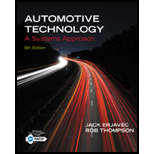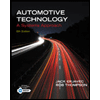
Automotive Technology: A Systems Approach (MindTap Course List)
6th Edition
ISBN: 9781133612315
Author: Jack Erjavec, Rob Thompson
Publisher: Cengage Learning
expand_more
expand_more
format_list_bulleted
Concept explainers
Textbook Question
Chapter 37, Problem 4ASRQ
While discussing the purpose of a clutch pressure plate: Technician A says that the pressure plate assembly squeezes the clutch disc onto the flywheel. Technician B says that the pressure plate moves away from the clutch disc so that the disc can stop rotating.
Who is correct?
a. Technician A only
b. Technician B only
c. Both A and B
d. Neither A nor B
Expert Solution & Answer
Want to see the full answer?
Check out a sample textbook solution
Students have asked these similar questions
The clutch friction disc always rotates with the
4) Explain the importance of a cone clutch with an application.
Technician A says that the clutch-style limited slip differential uses a multi-plate clutch pack between each side gear and the differential case. Technician B says that if the clutch discs are worn, rotating torque will be higher than specifications. Who is correct?
Chapter 37 Solutions
Automotive Technology: A Systems Approach (MindTap Course List)
Ch. 37 - Name two types of friction facings.Ch. 37 - True or False? If the fluid reservoir for a...Ch. 37 - What is another name for the diaphragm spring?Ch. 37 - Name three types of clutch linkages.Ch. 37 - What is used to measure clutch pedal play?Ch. 37 - The clutch, or friction, disc is connected to the....Ch. 37 - Torsional coil springs in the clutch disc_____. a....Ch. 37 - The pressure plate moves away from the flywheel...Ch. 37 - Which of the following is probably not the cause...Ch. 37 - When the clutch pedal is released on a hydraulic...
Ch. 37 - When the clutch is disengaged, the power flow...Ch. 37 - Insufficient clutch pedal clearance results...Ch. 37 - Before making a clutch adjustment, it is necessary...Ch. 37 - The surface of the pressure plate contacts the. a....Ch. 37 - Which of the following would not cause clutch...Ch. 37 - Technician A says that clutch slippage is most...Ch. 37 - While discussing ways to determine if a pilot...Ch. 37 - While discussing the different types of pressure...Ch. 37 - While discussing the purpose of a clutch pressure...Ch. 37 - Technician A says that an oil-soaked clutch disc...Ch. 37 - While discussing different abnormal clutch noises:...Ch. 37 - Technician A says that incorrect clutch adjustment...Ch. 37 - While discussing the cause of a pulsating clutch...Ch. 37 - Technician A says that if the hydraulic clutch...Ch. 37 - Technician A says that all manual transmission...
Knowledge Booster
Learn more about
Need a deep-dive on the concept behind this application? Look no further. Learn more about this topic, mechanical-engineering and related others by exploring similar questions and additional content below.Similar questions
- All of the following are functions of the flywheel, except it ____ . a. provides a mounting place for the clutch assembly b. smooths out cylinder firing pulsations c. has marks used to set the valve timing d. meshes with the starter drive geararrow_forwardThe clutch, or friction, disc is connected to thearrow_forwardQuestion No.16: a.) Describe the working principle of fluid fly wheel with the help of a sketch. b.) Explain the centrifugal clutch and semi-centrifugal clutch with neat sketch.arrow_forward
- The pressure plate moves away from the flywheel when the clutch pedal is.arrow_forwardIn briefly Explain why Remaining Options are incorrect. 1)The cone clutches have become obsolete because of (a) small cone angles (b) exposure to dirt and dust (c) difficulty in disengaging (d) all of thesearrow_forwardWhat are the suggestions to prevent the occurrence of failures in car clutch?arrow_forward
- the number one cause of clutch disc failurearrow_forwardWhat are the 4 main function of the clutch?arrow_forwardTechnician A says a purpose of a lockup piston clutch is to improve fuel economy. Technician B says a lockup piston clutch is designed with a damper assembly to transmit driving torque and absorb shock. Who is correct?arrow_forward
- When the clutch pedal is released on a hydraulic clutch linkage, the ___.a. master cylinder piston is returned by springtensionb. master cylinder piston is returned by hydraulic pressurec. slave cylinder is returned by hydraulic pressured. slave cylinder piston does not movearrow_forwardA car jumps out of gear into neutral, particularly when decelerating or going down hills: Technician A checks the shift lever and external gearshift linkage first. Technician B says that the clutch pilot bearing could be the problem. Who is correct? a. Technician A only b. Technician B only c. Both A and B d. Neither A nor Barrow_forwardTechnician A says that if the shift for all forward gears is delayed, a slipping forward clutch is normally indicated. Technician B says that a bad forward clutch is indicated when there is a slip when the transmission shifts into any forward gear. Who is correct? a. Technician A only b. Technician B only c. Both A and B d. Neither A nor Barrow_forward
arrow_back_ios
SEE MORE QUESTIONS
arrow_forward_ios
Recommended textbooks for you
 Automotive Technology: A Systems Approach (MindTa...Mechanical EngineeringISBN:9781133612315Author:Jack Erjavec, Rob ThompsonPublisher:Cengage Learning
Automotive Technology: A Systems Approach (MindTa...Mechanical EngineeringISBN:9781133612315Author:Jack Erjavec, Rob ThompsonPublisher:Cengage Learning Automotive TechnologyMechanical EngineeringISBN:9781337794213Author:ERJAVEC, Jack.Publisher:Cengage,
Automotive TechnologyMechanical EngineeringISBN:9781337794213Author:ERJAVEC, Jack.Publisher:Cengage,

Automotive Technology: A Systems Approach (MindTa...
Mechanical Engineering
ISBN:9781133612315
Author:Jack Erjavec, Rob Thompson
Publisher:Cengage Learning

Automotive Technology
Mechanical Engineering
ISBN:9781337794213
Author:ERJAVEC, Jack.
Publisher:Cengage,
Mechanical Design (Machine Design) Clutches, Brakes and Flywheels Intro (S20 ME470 Class 15); Author: Professor Ted Diehl;https://www.youtube.com/watch?v=eMvbePrsT34;License: Standard Youtube License